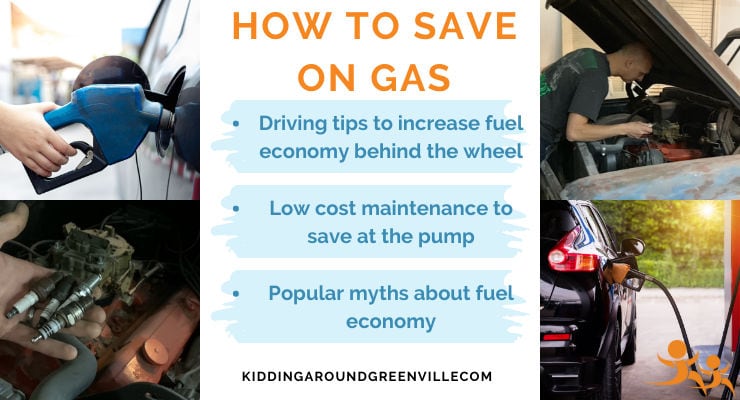Are you looking for ways to save fuel and a little money at the gas pump? With gas prices rising and people trying to cut down on their fuel consumption, we wondered what things we could do to save gas by increasing our gas mileage or fuel economy. Fortunately, we have a “car guy, engineer, husband” in our midst and he’s here to help Kidding Around Readers save money on gas at the pump.
This article includes:
Driving Tips to Save Gas for FREE
Does cruise control save gas?
Does “Eco Mode” really save gas?
Simple Maintenance that will Save Gas and Money
What is the cheapest thing to do to your car to help save gas?
Myths About Fuel Economy
This article is provided for general informational purposes only. Consult a certified mechanic for specific information and requirements for your particular vehicle.
Concerned about how gas prices might affect vacation? Plan a vacation near home. Try these amazing vacations within 90 minutes of the Upstate!
How to Save Gas
Whether you want to cut down on your consumption of fuel or just save some money at the gas pump, you might be asking yourself “How do I save on gas?” We wondered the same thing, so we asked our family “car guy,” mechanical engineer some questions about how to save gas.
Driving Habits for Saving Gas
What are some ways drivers can save gas on the road?
- Drive Slower. You’ll save up to 14% by slowing down to the speed limit. Usually, you hit the brakes more when you go faster. This means you slow down more often and more abruptly. You end up using energy in the gasoline without going anywhere. The energy just turns into heat with the brake pedal. Essentially, if you have to brake less, you’ll waste less fuel accelerating. So, slow down. Coasting gradually to a stop sign or traffic light when possible is a good idea.
- Don’t tailgate. Keep a large distance between you and the vehicle in front of you. This reduces the need to brake and increases opportunities to coast.
- Limit Passing: You’re not racing. There’s no need to speed up to pass a car in front of you that’s only going a few miles an hour slower than you’d like. If you can’t make meaningful gains in the traffic, just wait. Have you ever flown by someone only to have them pull up beside you at the traffic light? You spent more money than they did on fuel to get to the same place at the same time. You didn’t need to do that.
- Carpool if you can.
- Combine trips when possible. Drive less.
- Start/Stop Feature: If your car has a stop/start feature, leave it on, even if it annoys you. If your car is shut off for as little as seven seconds you will start to see meaningful gains in fuel economy.
- Sport Mode: If your car has a sport mode or tow/haul mode do not use it unless you actually need it. Doing so will delay the lock up of your torque converter and raise your shift points which will both negatively affect your fuel economy.
- Parking lots: Don’t drive around looking for a spot! Just park in the first available spot and walk.
- Run your AC less. If you can, make your trips in the early morning or cooler evening when you won’t need to run the air conditioning as frequently.
- Consider your destinations. Can you shop at a closer store? Or, maybe you can wait a few days to have an item shipped to your door? If you have to run your kids to an activity, maybe you can grab dinner from the restaurant next door instead of driving across town.
Does cruise control save gas?
Cruise control helps to save gas for long trips if the traffic allows it. If the cruise control is off and on frequently due to traffic, it is likely not saving fuel.
Does “Eco Mode” improve fuel economy?
The short answer is that yes, eco mode often helps. But, it depends because that mode can mean different things to different manufacturers.
If you want to know about how cruise control and eco mode affect the fuel economy in your vehicle, on your routes, experiment with both of them. Calculate your fuel economy. Don’t rely on your car’s dashboard for this. Fill your tank and reset your odometer, drive until it’s nearly empty, and then refill. Simply divide the miles you drove by the gallons you just put into your car. Then try a different strategy with eco or cruise control and compare the numbers.
Save Gas With Car Maintenance
What car maintenance issues affect gas mileage?
- Tire Pressure: This is easy and free. Not only will you increase your fuel economy by as much as 3% but you’ll lengthen your tire life. Follow the manufacturer’s recommendation for tire pressure. Do not simply go by the tire sidewall.
- Spark plugs: How long has it been since you changed your spark plugs? I bet you don’t even know. Fresh spark plugs can make a surprising difference in fuel economy for very little money.
- Oil changes: Follow the manufacturer’s recommendation for oil change interval. Do not attempt to game the system by changing the oil viscosity on your own. Always follow the oil viscosity recommendations in the owner’s manual. You risk increasing engine wear and decreasing fuel economy by doing so. Unless you’re an engine designer in your spare time, do not mess with oil viscosity.
- Remove the roof rack that you haven’t used since that ski trip in 1997. It could be costing you as much as 25% fuel economy. The big ones are especially bad. Consider removing roof racks and roof cargo carriers between uses if you don’t use them regularly.
- Tire type: Love the off-road look? So do the gas stations. They are making big money off of you. Off-road or mud tires can decrease fuel economy by up to 15%. Consider your actual usage when purchasing tires.
- Check engine lights. Do not put a piece of tape over it. Do not listen to anyone who tells you it’s “just a sensor.” Find a certified mechanic and fix it. Not only will it help fuel economy, but it will probably save you money down the road on more severe repairs.
What are the cheapest items to address that will increase gas mileage?
- Tire pressure. It’s free.
- Roof rack. Free.
Just these two things can increase your fuel economy by a significant amount.
Gas Saving Myths
Don’t fall for any myths or tricks. These things will not help you save gas, increase fuel economy, or save you money at the pump.
Are there any popular thoughts about saving gas that are untrue?
- Air filters do not affect fuel economy. (This does not mean that you should not change your air filter when it is required!)
- In modern vehicles, a brisk acceleration to your desired speed is the best for fuel economy. Slow starting is a myth. (Don’t drag race either, please. Follow speed limits.)
- Approach aftermarket accessories marketed to increase fuel economy with extreme skepticism. They may even permanently damage your engine.
- Do not attempt to increase fuel economy by buying higher octane fuel. This will not work. Use the fuel recommended by the manufacturer in the owner’s manual. If the manufacturer could get better fuel economy out of a higher octane fuel, they would have told you to use it.
- Don’t attempt to increase fuel economy by cutting exhaust or installing a louder muffler. Modern exhaust systems are very well designed and you will not see gains on an otherwise stock engine by modifying the exhaust system.
What are you doing to save gas?


































